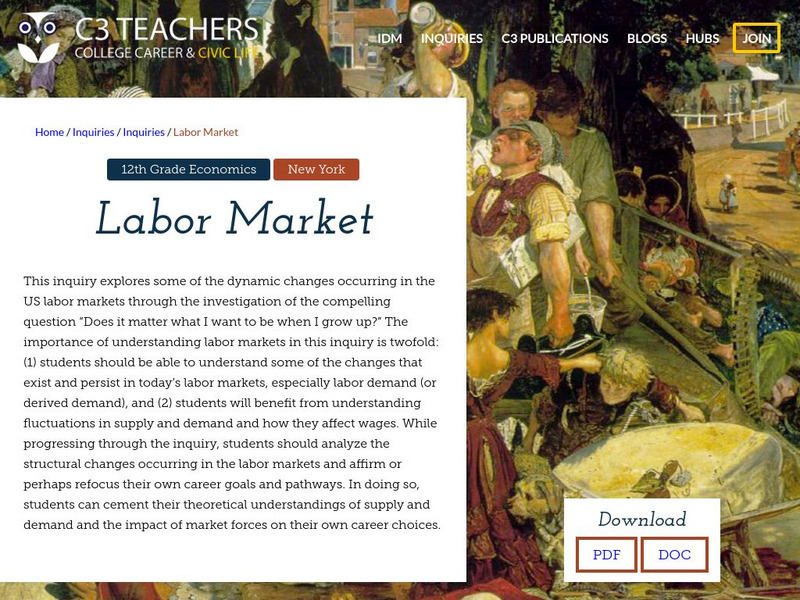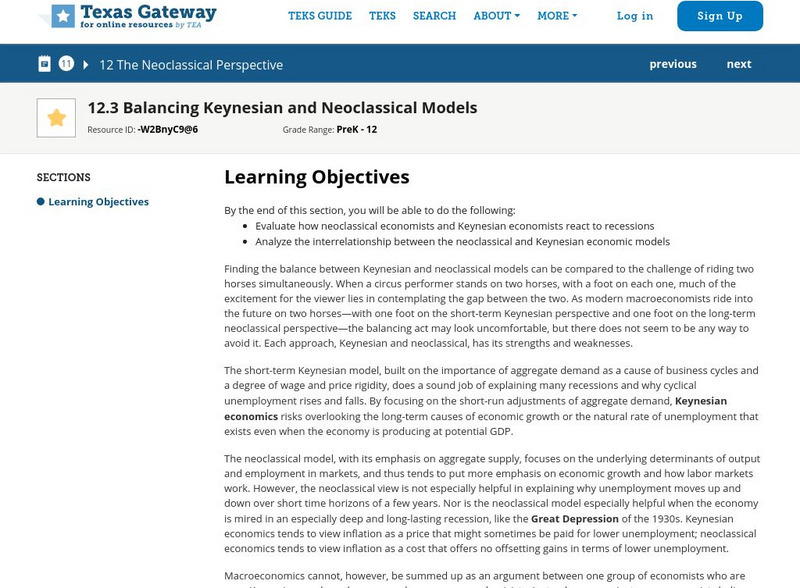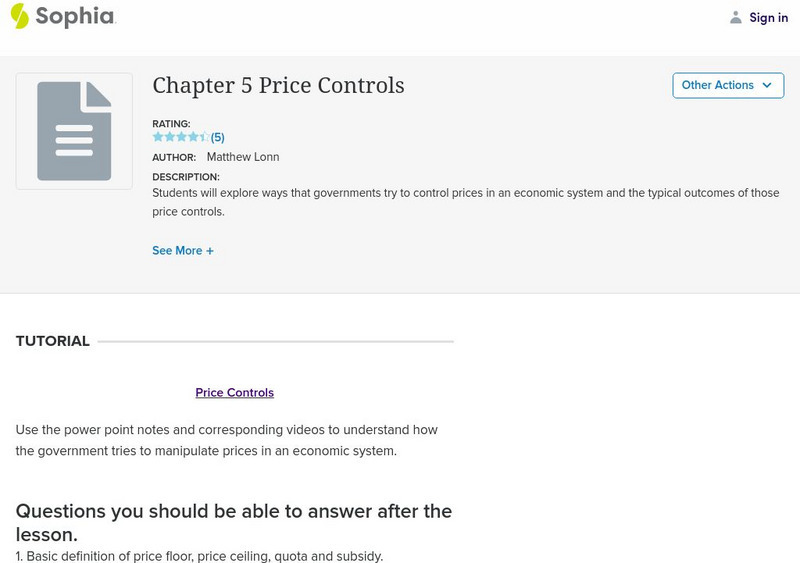ClassFlow
Class Flow: Economics Vocabulary
[Free Registration/Login Required] This flipchart explains basic economics vocabulary such as producers, consumers, and different kinds of resources; limited, unlimited, natural and human. Student assessment items are included.
Other
South Western Learning: Econ News: Comparative Statics: Perfect Competition
This site offers economics-based newspaper headlines and asks follow-up questions based on supply and demand in a perfectly competitive market.
Texas Education Agency
Texas Gateway: Chapter 7: What Causes Changes in Unemployment Over the Short Run
By the end of this section, you will be able to do the following: Analyze cyclical unemployment, Explain the relationship between sticky wages and employment using various economic arguments, and Apply supply and demand models to...
Khan Academy
Khan Academy: Shifts in Aggregate Supply
If either the aggregate supply or aggregate demand curve shifts in the aggregate demand/aggregate supply-AD/A-model, the original equilibrium in the AD/AS diagram will shift to a new equilibrium. Increases and decreased in the price of...
Khan Academy
Khan Academy: Lesson Overview: Consumer and Producer Surplus
This lesson introduced the basics of a branch of economics known as welfare economics, which is interested in how the allocation of resources affects well-being. The most important concepts used in welfare analysis are total surplus and...
Khan Academy
Khan Academy: Determinants of Price Elasticity and the Total Revenue Rule
Practice what you've learned about the relationship between price elasticity of demand and total revenue in this exercise. This resource is designed as a review for the AP Microeconomics Test or a college-level microeconomics course.
Council for Economic Education
Econ Ed Link: Collecting for Fun . . . And Profit?
Art, baseball cards, coins, comic books, dolls, jewelry and stamps are just a few examples of the many things people collect. While some people collect for fun, others hope to profit. For this lesson, young scholars explore how supply...
Khan Academy
Khan Academy: Price Ceilings and Price Floors
This article discusses how quantity demanded react to artificial constraints on price.
Khan Academy
Khan Academy: Changes in Equilibrium
Practice more challenging questions about changes in market equilibrium that happen when supply or demand (or both!) change in this exercise. This resource is designed as a review for the AP Macroeconomics Test or a college-level...
Khan Academy
Khan Academy: The Market Model
This study resource will help students understand, and create, graphs that are critical skills in macroeconomics. This article reviews the market model. This resource is designed as a review for the AP Macroeconomics Test or a...
Other
Gazillionaire
Play the game of business strategy. Wheel and deal to "determine where supply meets demand." Fun way to learn about the business world.
Other
South Western Learning: Oligopoly/monopolistic Competition: Kinked Demand Curve
This South-Western College Publishing website describes a situation in which oligopolistic firms vie for competition among consumers.
Khan Academy
Khan Academy: Macroeconomic Perspectives on Demand and Supply
Read about the differing macroeconomic perspectives of Keynes and Say.
Council for Economic Education
Econ Ed Link: What Do People Want to Wear?
To stay in business, fashion merchandisers must be able to anticipate what consumers want. By looking at different retail websites, students will look to anticipate what consumers are demanding. Students will then go through the market...
Council for Economic Education
Econ Ed Link: Tapped Dry: How Do You Solve a Water Shortage?
Economists do not operate in a vacuum. If an economist is going to suggest that the price of a good needs to be increased, he or she needs to consider who will bear the increase in costs. Will the costs be distributed equally or will one...
Khan Academy
Khan Academy: Law of Demand
If the price of something goes up, people are going to buy less of it.
Council for Economic Education
Econ Ed Link: The Economics of Recycling
Students will review the legislation in Japan that requires all consumers to pay a fee for recycling large appliances.
Council for Economic Education
Econ Ed Link: The Economics of the Family Farm
Learn about the status of farming as a career, investigate the management of a family farm, and examine one recent farm crisis in this lesson.
Council for Economic Education
Econ Ed Link: Widget Production: Producing More Using Less
Through this economics lesson you will learn about widget production. One of the tasks is to see how productivity can help solve problems.
C3 Teachers
C3 Teachers: Inquiries: Labor Market
A comprehensive learning module on the US labor market that includes three supporting questions accompanied by formative tasks and source materials, followed by a summative performance task. Topics covered include economic trends that...
Texas Education Agency
Texas Gateway: Ch. 12: The Policy Implications of the Neoclassical Perspective
By the end of this section, you will be able to do the following: Discuss why and how inflation expectations are measured, Analyze the impacts of fiscal policy and monetary policy on aggregate supply and aggregate demand. Explain the...
Texas Education Agency
Texas Gateway: Chapter 12: Balancing Keynesian and Neoclassical Models
By the end of this section, you will be able to do the following: Evaluate how neoclassical economists and Keynesian economists react to recessions and Analyze the interrelationship between the neoclassical and Keynesian economic models.
University of Minnesota
University of Minnesota: 2.1 Factors of Production: Principles of Economics
The three factors of production-labor, capital, and natural resources. Explain the role of technology and entrepreneurs in the utilization of the economy's factors. Labor is the human effort that can be applied to the production of goods...
Sophia Learning
Sophia: Price Controls
Lesson uses power point notes and related videos to help students understand ways that the government tries to control prices in an economic system, and what the expected results are.





















